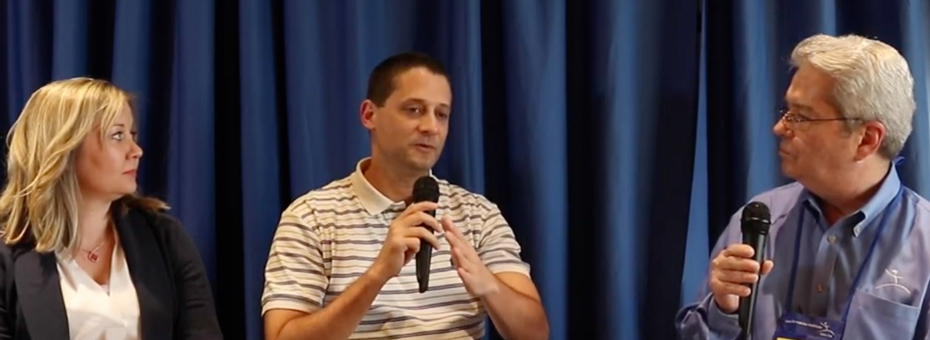At the center of a Lean Product and Process Development effort is a single responsible leader called the chief engineer who heads a team that creates the new product or service concept, develops the business case, conducts the technical design, manages the development process and takes it into production, coordinating the effort with production engineering, sales, and marketing.
Chief engineers typically have strong technical skills to effectively lead and manage the work of engineers, designers, and other developers on the team. But perhaps their greatest talent needs to be nontechnical, an observation that emerged in this interview with two chief engineers from TechnipFMC, conducted by LEI Communications Director Chet Marchwinski at the 2019 Designing the Future Summit. The interview was edited for length. Read the full version here.
Alan Labes is chief engineer of the Subsea 2.0 platform and the company’s first-ever chief engineer. He has held leadership roles in product development, engineering, and systems engineering. Allison Weber is the chief product developer of the Subsea 2.0 “tree” product lines. She has held leadership roles in several subsea tree projects and product development groups. Today, they discuss how their responsibilities for managing and leading product development teams changed as CEs. In the second story, they discuss the evolution of the critical obeya process, which is centered in a war room for sharing information visually.
Q: Alan, you’re the first overall CE and Alison is a CE on a critical system of Subsea 2.0, a major product. What were the key challenges for each of you as chief engineers?
Alan: We heard a lot about, “You need to lead without authority.” What does that mean? My role was very challenging because [Subsea 2.0] is a very large system and we always expected the chief engineer to be extremely technically knowledgeable about the product. But when we assembled the team, I would think, “I am the least knowledgeable guy in the room because we have experts for every subject.” For instance, Alison is an expert on Christmas trees.
For me, it was really hard to get this thing about leadership without authority. It started to gel once I could convey to the team what was the vision I had for the future of the company and how this product should transform the whole company. It was high level but broader that would touch every product consistently, so they all shared the same single vision. That’s when we started to gel. Then we needed to have mutual respect for what each one of us was bringing to the project.
Q: Allison, what were your challenges?
Passion for the product is an extremely important skill for a chief engineer, not only to have it but also to convey it.Allison: The way it was explained to me was, “You’re in charge of developing this product and its value stream.” My biggest challenge was wrapping my mind around what that really means; what is the value stream of a tree. And do I understand everything about that flow? As Alan was saying, you have to lean on the experts around the organization. We knew how to get things to a strong technical state, but then we would pass these other process developments to the rest of the organization. So being able to tap into that knowledge for supply chain and sourcing or manufacturing processes and things like that has been one of my biggest challenges as a chief engineer.
Q: You’re both experienced managers and leaders, but as CE’s what changed about the ways you managed and led?
Allison: Being given responsibility for a product changed the way I cared for how development succeeded. Historically, you’re graded on meeting schedule and budget, for example. But having the product be the center of your development was a shift. It changed the way that I led and communicated that vision to my team to make sure that we were all product-focused and that the decisions we made were the best for the product and not the best thing for short-term gains, schedule, and budget. The long-term effects of what we were doing were so substantial that having that foresight early on was important.
The other thing that changed was we wanted to expose problems and be transparent about them. When you ask that of your team, it’s important that you don’t just ask for people to tell you problems, but you work with them to solve problems. That takes a lot more time and energy. It’s give-and-take and developing trust with your team so when they tell you a problem, you have to really be by their side and help them solve it.
Q: Alan, how about you? What was different about the way you managed and led?
Alan: Allison touched on it; the chief engineer needs to deliver a new value stream for the company. Before we were doing engineering for a project, so it’s short term. When you think about what it means to deliver a value stream, it’s connected to the sustainability of the business, to the strategy of the company. So at the beginning of the project, we were talking about the sustainability of the industry. What we wanted to do is change the industry. So in the chief engineer role, we go from what we want the product to look like, to the details of how does it perform, how we are going to manufacture it, are the clients going to buy, how you are going to do the marketing, how are you going to service it in the future.
You need to rely on the experts in every discipline to make it happen. So it’s a big task engaging everybody to align on that vision and leading, as they say, without authority. How do you promote this leadership? I think it’s conveying the vision with passion. You need to have passion for the product, for what we’re trying to do, and this passion has to permeate the organization.
Q: It’s no longer “just do it” because I said so.
Alan: Yes, because engineers are amazing. I never did what I was told to do. We are rebels. I hope my boss doesn’t watch this, but I always did what I wanted and I think everybody will always do what they want. You can only get what you want with alignment. So product development pulls the alignment and the tool is passion – passion for the outcome, for the vision. Passion for the product is an extremely important skill for a chief engineer, not only to have it but also to convey it.
Designing the Future
An Introduction to Lean Product and Process Development.






